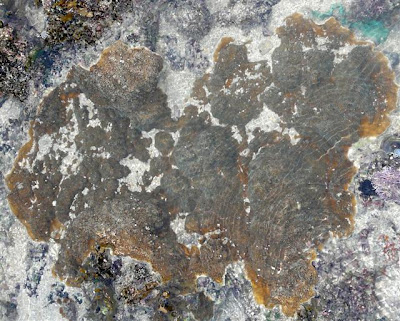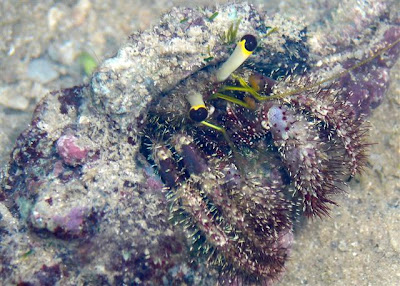
It's amazing that a touristy island like Sentosa or Pulau Blakang Mati still have a stretch of natural shore of coral reef exposed at low tides.

There are many different types of corals at Sentosa including the Porites sp. coral and the Disk hard coral (Turbinaria sp.).

There are also corals that are boulder-looking. This is a favid coral.

There are also longish corals like this mushroom coral. Unlike other corals, the mushroom is a solitary animal.

This another mushroom coral where you can see its polyp tentacles out when the bottom part of the coral is in contact with the water of the tide pool.

I also encountered many corals in foliose growth form on the rubble area.

A closer look reveals many starry looking polyp individuals of the coral. This is probably a Montipora sp..

There are also some corals with I have no idea of its species due to be incompetency in coral identification.

A closer look of the unknown coral. Good thing Ria highlighted to me that this is a Hydnophora hard coral which is quite rarely seen.

This is yet another coral which I'm not sure of its identification. Could it be a faviid coral?

One more interesting looking boulderly coral.

Wow, Sentosa indeed has many different types and shapes of corals!

One of the surprises will be this Acropora coral which I've not personally seen at Sentosa. This coral is quite sensitive to not so clear waters and can usually be found at clearer reefs like Raffles Lighthouse.

This is a Cauliflower hard coral (Pocillopora sp.).

Of course, there also also many soft corals other than the above hard corals featured in this post.

This soft coral is commonly known as the omelette soft coral interestingly.

Unlike hard coral polyps, soft coral polyps come in eights.

With corals, of course there are another reef animals like this egg crab.

Like the egg crab, this mosaic crab is very poisonous and they shouldn't be consumed!

There are also many black long sea cucumbers that if disturbed, will eject their internal organs onto you. Jerald is one good person to testify how sticky its thread are!

This giant reef worm is frequently seen at Sentosa. The species name is Eunice sp.. Though sound elegant, it has a face only its mother could love. These long reef worms usually come out from their crevices to snatch seaweed before going back to hiding.

The guided walk friends also found a very interesting hermit crab (in line with NHC) with yellow and black eyes. It is a Dardanus hermit crab (Dardanus sp.).

There are also many barrel's sponges found on the shore.

Could this be a juvenile sweetlip fish?

This master of camouflage was really hard to catch for the rest to see. Geraldine and I witnessed its colour changing power!

Of course there are many flatworms.

And also our favourite polka dot nudibranch.

Interestingly, there are quite a number of this purplish looking phyllid nudibranch on the shore.

While photographing the above nudibranchs, I saw this tiny one at the side as well. This nudibranch is Phyllodesmium briareum. What is amazing is that is nudibranch is 'solar powered' and keeps brown algae in its skin of its body which give it is brown colour. Eventually the zooxanthellae in the skin die and can only be replaced by eating the right soft coral. Until they feed again, the nudibranch can become quite pale.

It's wonderful to share the natural wonders with everyone.
I couldn't guide today as I had to leave early for my Sunday service. But it was nice to be a hunter seeker once in a while :-)
Beautiful photos of nature. That crab looked delicious, wow did not know it is poisonous. Thanks for the information.
ReplyDelete